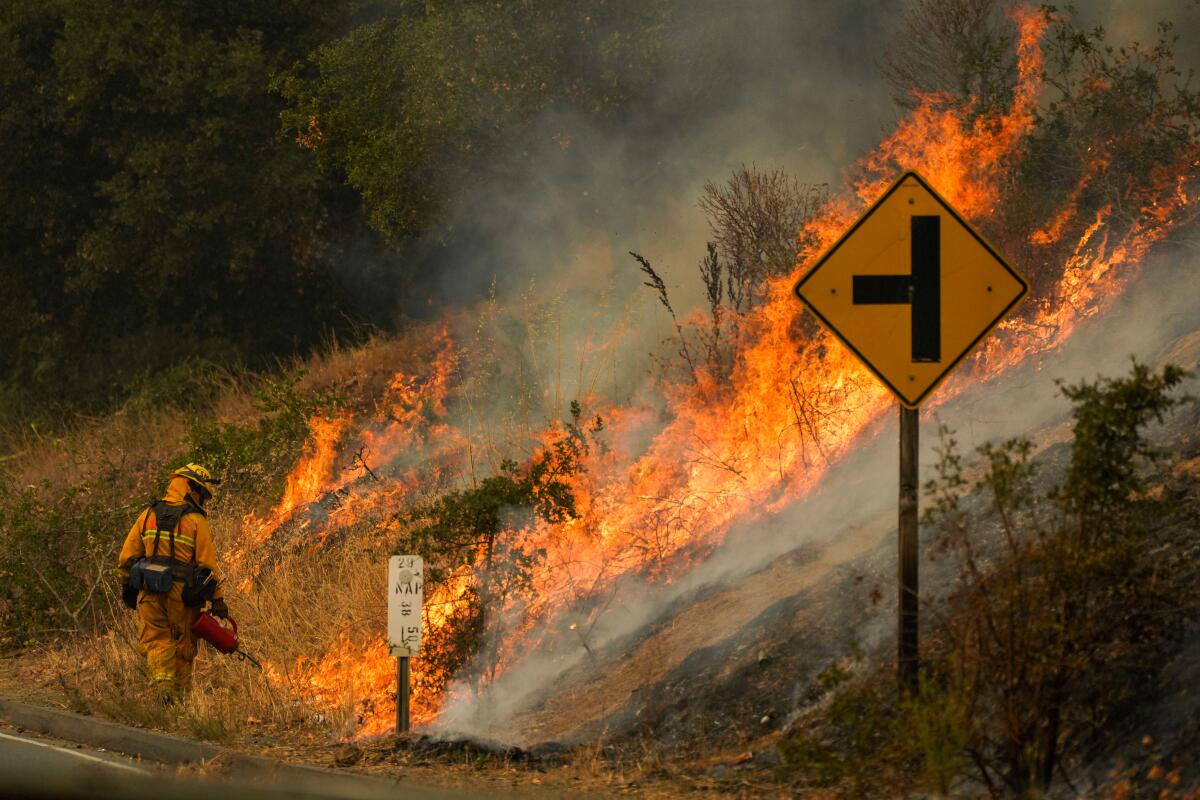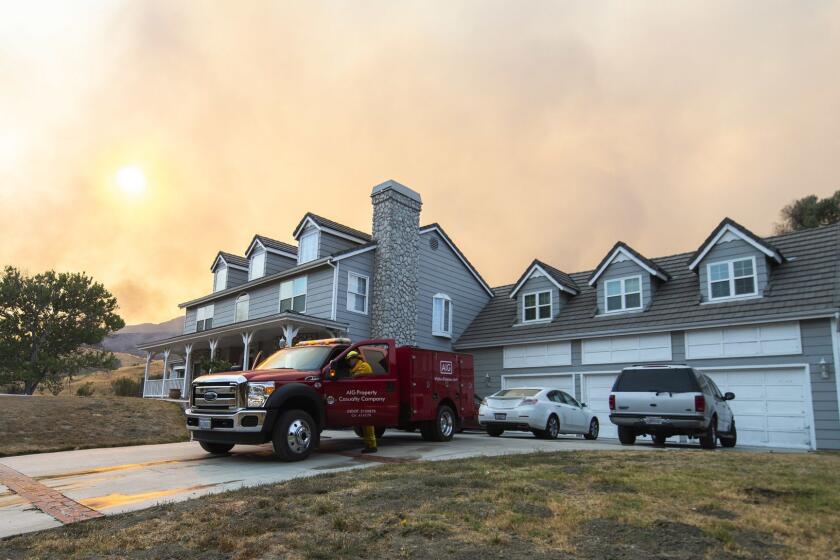Private fire crews in wine country raise concerns over equity and safety

- Share via
As California wildfires get worse, the role of private firefighting crews helping well-heeled clients protect their property has become a growing issue from Brentwood and Malibu to Napa and Sonoma.
Authorities are now investigating new allegations that private crews set illegal backfires last week during the destructive Glass fire, which has swept through wine country. California Department of Forestry and Fire Protection investigators confirmed that they were examining the claims but provided few details about the location of the backfires or who hired the crews.
The Glass fire has destroyed numerous wineries in Napa and Sonoma counties and hit upscale communities along Highway 12, one of the main roads through wine country.
The investigation is heightening scrutiny around the use of private crews, which has been a repeated source of concern among fire departments and was the subject of new laws after numerous private companies were seen across Malibu and Calabasas during the 2018 Woolsey fire.
Private firefighters were credited with helping save Kanye West and Kim Kardashian’s $60-million Calabasas mansion from the Woolsey fire.
“We were able to get private firefighters,” Kardashian told Ellen DeGeneres in a 2018 interview. “They saved our home and saved our neighborhood.”
When the Woolsey fire swept into the exclusive neighborhood of Bell Canyon, resident Yen Hsieh grabbed her late music teacher’s 200-year-old cello, some belongings and her son’s betta fish Sparky and fled, not sure whether her home would be destroyed.
Brian Rice, president of California Professional Firefighters, a labor union representing more than 30,000 professional firefighters in the state, said he was not surprised private crews joined the fight in wine country.
“The Glass fire … is just part and parcel of the issues and the problems that we are running into with private, for-profit fire protection companies,” Rice said. “If they’re behind fire lines, they are an absolute liability to the community and to the fire department.”
Rice said for-profit firefighting groups have become something of a cottage industry in California in recent years, particularly as the state has experienced an uptick in wildfire activity. And when private, for-profit groups come in and don’t follow protocol, they can confuse residents, get in the way of firefighting activities or even require assistance themselves.
“Let’s not mince words,” Rice said. “They’re here to make a profit, and they’re here to make a profit on the backs of Californians that are suffering in some of the worst fire tragedies in history.”
Backfires are typically used by professional firefighting agencies to consume fuel in the path of a wildfire or to change the direction of a blaze.
But private firefighters — civilians often hired by insurance companies to protect defensible spaces such as homes and properties — are not authorized to use them as a defense mechanism. Instead, they are supposed to do preemptive work such as clearing vegetation, setting up perimeter sprinkler systems or spraying the area around a property with fire-blocking gel or retardant. The goal is to prevent flames from reaching a structure.
“They are not to fight fire when they’re in there,” Cal Fire spokesman Scott McLean said. “They are not to make a stand.”
During the 2018 Woolsey fire, private firefighters in the tony Bell Canyon neighborhood of Ventura County generated complaints from fire officials who said they didn’t always coordinate with local crews.
“It’s a liability and safety issue,” Ventura County Fire Capt. Brian McGrath said at the time.
Officials from California Professional Firefighters said interference from private firefighters became such a problem during the 2018 fires that the group sponsored legislation to try to regulate the service.
Assembly Bill 2380, signed by Gov. Gavin Newsom in September of that year, required the development of standards and regulations to govern private firefighters.
Among the requirements: Private firefighters must heed all evacuation orders, check in with fire operators before entering an area and focus primarily on pre-fire and nonemergency activities outside restricted areas to minimize potential liability.
The backfires in Napa and Sonoma counties are alleged to have occurred last weekend, when red flag warnings indicating hot, dry conditions were in effect. The Glass fire has burned through more than 67,000 acres since igniting Sept. 27.
Sometimes seen as a “white-glove service” for homeowners in well-to-do neighborhoods, private firefighting services have raised eyebrows for creating potential inequities in the land of wildfires — making it easier for wealthy people to protect their homes while leaving little recourse for those without flush resources.
But David Torgerson, chief executive of Montana-based Wildfire Defense Systems — one of the leading private firefighter contractors in the nation — said there are no inequities in the services his company provides, which are becoming standard policy for insurance company packages.
“In the programs that we serve, 90% are average-value homes,” Torgerson said. “And because there’s dozens of insurance companies that offer this, anybody can have it. They just have to ask their agent or broker.”
Wildfire Defense Systems has deployed to more than 900 wildfires on behalf of the insurance industry since 2008, including 70 in California this year alone, with the express purpose of preventing structures from igniting.
Torgerson said federal and state governments are the biggest users of private wildfire contractors. (More than 11,300 firefighters contract with state and government agencies nationwide, according to the National Wildfire Suppression Assn.). The insurance industry comes in second, and roughly 3% work directly for landowners.
It’s those who create a lot of the issues, Torgerson said.
“This very small fraction of wildfire contractors is getting all this attention,” he said, “and that’s what they’re referring to in those media articles.”
Janet Ruiz, spokeswoman for industry group Insurance Information Institute, said a “few dozen” insurance agencies contract groups year-round to do on-site wildfire hazard assessments and proactive defense, such as clearing pine needles from roofs, moving wood away from houses and spraying retardant.
Insurance firms such as AIG, Chubb and USAA have provided the services in wildfire-prone states for more than a decade, but an increase in requests for the services has coincided with the nation’s increasing wildfire risk, she said.
The groups also offer post-fire services, including returning combustible materials that may have been relocated from homes or removing firefighting gel from where it was applied.
Like Torgerson, Ruiz said state agencies such as Cal Fire usually “welcome all the help they can get,” adding that it’s only the bad apples that spoil the bunch.
“The only times they’re not happy is when it’s people doing things like coming on the scene to fight fire and not checking in, not showing their credentials, etc.,” she said. “That’s not what the insurance industry is supporting.”
But wildfires in California are unlike anywhere else on Earth, Rice said, save for possibly Australia. The terrain is brutal, the blazes are complex, and anyone coming into the area will be facing one of the most unpredictable and unprecedented eras in wildfire history.
“It is incredibly risky. It is incredibly hazardous,” Rice said. “And I can just see the profit motivation beginning to take hold across the West.”
Cal Fire has not yet named the agencies or firefighters being investigated for the backfires in Napa and Sonoma counties, but Rice said that if the claims are proved, it could be considered arson. Setting backfires requires highly skilled, highly trained and highly certified firefighting officials.
“It is a planned process, and we are very meticulous about what we do,” said McLean, the Cal Fire spokesman. “Putting fire on the ground is very serious business.”
More to Read
Sign up for Essential California
The most important California stories and recommendations in your inbox every morning.
You may occasionally receive promotional content from the Los Angeles Times.















